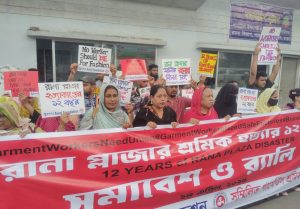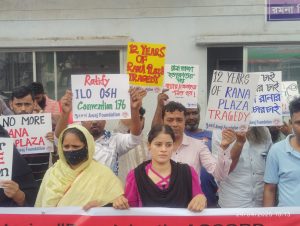The morning sun had already cast its light when Yanur, like every other day, went to her job at a garment factory driven by the urgency to earn a living. She was working on the sixth floor when the building began to collapse. In an instant, she was buried under the rubble.
After her rescue, Yanur underwent six surgeries on her limbs. Her left leg remains nearly useless. She drags herself forward with one functioning limb. Spinal pain prevents her from sitting upright for long. Numerous other physical complications persist.
The trauma of the Rana Plaza tragedy on April 24, 2013, continues to haunt Yanur. That single collapse took 1,138 lives, and injured over 2,500 others—most of them garment workers, many like her still struggling through a life of pain and poverty.
“We never received fair compensation,” Yanur told Times of Bangladesh. “We’re in no financial state to run our families. It’s been 12 years, and we protest every year, asking for proper compensation, treatment, and rehabilitation. But no one listens to us.”
Choking back tears, she added, “I can’t even feed my child a handful of rice. Sometimes I wonder why I didn’t just die that day!”

Kobir Molla was working on the fourth floor of Rana Plaza when the building collapsed. Trapped in the rubble for four days and nights, he witnessed at least 25 colleagues die slowly. One drank urine to survive due to the lack of water. “I was hospitalised at CMH for 15 days,” he recalls. “Even now, I sleep with the lights on. I can’t stay alone. That fear never left me.”
“It’s been 12 years, and I haven’t received even a single taka in compensation,” he claimed. “Nobody is there for us.”
Md. Sujan, a labour leader in Savar, stated: The Rana Plaza tragedy wasn’t an accident—it was systemic murder. We’ve been demanding justice and compensation for 12 years. We won’t stop until our demands are met.
One year after the tragedy, in 2014, the then Awami League government, following a High Court directive, formed a high-level committee to oversee compensation. The committee recommended: Tk 14,51,300 for each worker permanently disabled, Tk 7,50,000 for a worker who lost a limb, Tk 4,50,000 for each of those needing long-term medical care and Tk 1,50,000 for those suffering mental trauma.
Some workers reportedly received partial compensation in instalments. But many say the money ran out long ago, and their physical conditions prevent them from engaging in heavy work. For most, daily survival is a challenge, and affording medicines or medical tests is a distant dream.
The Rana Plaza collapse awakened the global conscience on worker safety. International buyers and human rights groups pressured the Bangladeshi government to ensure better working conditions.

As a result European brands formed the Accord, operating in Bangladesh until 2020, covering safety renovations in 92% of its listed factories.
American brands formed the Alliance, active until 2018, overseeing upgrades in 90% of their associated factories.
Mohammad Hatem, President of the BKMEA (Bangladesh Knitwear Manufacturers and Exporters Association), told Times of Bangladesh, “If any Rana Plaza worker still hasn’t received compensation, it’s very unfortunate. There were sufficient funds at the time.”
However, he said, there were cases of people falsely posing as victims to claim compensation. “And after all these years, identifying genuine victims is very difficult.”
“We now ensure maximum safety in garment factories. Compared to other countries, Bangladesh’s garment factories are the safest and most eco-friendly,” Hatem said,


